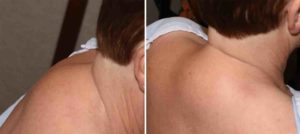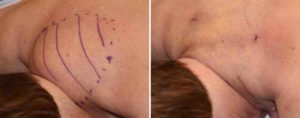Background: The buffalo hump deformity is a well known collection of fat in the back of the neck. It is a seemingly unusual place to develop a fatty collection given that it is a body area that is associated with becoming ‘fat’. But there is a congenital fat pad in the upper back known as the dorsocervical fat pad and an increase in its size may be a sign of excessive weight, a symptom of some diseases or a drug side effect.
Drug side effects that are known to increase cause lipodystrophy of the dorsocervical fat pad, the most recognized of which are some AIDS-treating medications. The other much more used drug that causes this effect are steroids including prednisone. Through an induced redistribution effect fat is directed to accumulate in the dorsocervical fat pad.
The formation of an increased upper back fat pad causes multiple aesthetic and functional symptoms. The aesthetic deformity is obvious even though it is on the back rather than in the front of the neck. A hump in the upper back is not natural nor aesthetically pleasing. Its mass effect also causes neck movement restrictions and discomfort. In some patients they complain about difficulty sleeping due to the mass on the back of their neck.


Regardless of the cause, buffalo humps do not recede or go away even when its etiology is eliminated. Liposuction is preferred over open excision as it is just as effective and avoids the risk of serum formation.
Highlights:
1) Buffalo humps come in a variety of sizes and causes.
2) Long term steroid use is known to cause more modest buffalo hump deformities.
3) Power-assisted liposuction is an effective aspiration technology for the fibrofatty tissue of buffalo humps.
Dr. Barry Eppley
Indianapolis, Indiana



